Alstom Coradia
| Alstom Coradia | |
|---|---|
.jpg) The Coradia 1000 Adelante (seen here at Moreton-in-Marsh) is a type of British diesel multiple higher-speed train built by Alstom. | |
| Manufacturer | Alstom |
| Specifications | |
| Track gauge | 1,435 mm (4 ft 8 1⁄2 in) standard gauge |
The Alstom Coradia family range of Inter-city trains and regional trains includes multiple unit diesel (DMU) or electric (EMU) as well as double-decker trains that can carry up to 900 passengers. As of 2018, the Coradia Polyvalent is the latest variant in the Coradia family.
There are a number of variants of this series, which have been operated across several countries. As of 2018, Coradia regional trains are in active service with operators in Germany, Denmark, the Netherlands, France, Finland, Luxembourg, Sweden, United Kingdom and Algeria.
Design
The Coradia is a family of high-performance rolling stock, manufactured by Alstom Transport and offered in various configurations to suit the varying requirements of operators.[1] It is available in both diesel multiple unit diesel (DMU) and an electric multiple unit (EMU) configurations; a high-density double-decker model, the Coradia Duplex, has also been developed. The Coradia uses Alstom's own Onix igBT traction system, which is promoted as providing smooth acceleration and energy conservation facilities.[1] The standard variants of the train are fitted with a regenerative braking system. The Coradia can also be equipped with a variety of communication and signally systems, including national automatic train protection (ATP) and European Train Control System (ETCS).[1]
The Coradia is designed to offer a high degree of comfort for passengers.[1] The design of the interior incorporates a modular philosophy; as standard, the passenger compartment features ambient lighting, luggage racks and storage areas, as well as partition walls located between the foyer and the seating areas. Each seat can be equipped with electrical sockets, individual lighting, and various audio and video systems; both the pitch and configuration of the seats are customisable to meet the operator’s requirements.[1] The internal fittings can be easily redistributed, being typically mounted onto purpose-built slots. Amongst the options available for customisation are equipment such as vending machines, in-train ticketing dispensers, and built-in internet provision; specialised accessibility facilities for disabled passengers can also be installed.[1]
The Coradia range of regional trains includes the Coradia Duplex, Coradia Lint, Coradia Continental, Coradia Polyvalent and Coradia Nordic variants.[1] Alstom has also developed the Coradia Meridian, specifically for Trenitalia and other regional operators in Italy. The Coradia Continental an EMU operated as either three, four, five or six-carriage sets; up to four train-sets can be joined during peak times.[1] The traction system is roof-mounted, freeing up room for a more spacious interior. Developed for German and other European markets, the Continental complies with the International Union of Railways (UIC) loading gauge standard and is suitable for platform heights ranging from 550mm to 760mm.[1]
The Coradia Duplex train is a double-decker EMU operated in two to seven-carriage sets; furthermore, up to four train sets may be coupled together for a maximum length of 12 carriages.[1] The Duplex range includes two models, one developed and used for TER services in France (designated Class Z 26500) as well as by Chemins de Fer Luxembourgeois (designated CFL 2200), while the other is used in Sweden.[1]
The Coradia Nordic is a wider body train, specifically developed for the large gauge standard commonly used in Northern Europe, and is available in configurations of four, five or six-carriage EMUs.[1] To enable its use during the harsh winters common to Scandinavia, it can be operated at temperatures as low as -35°C, as well as being stored as low as -40°C. To free up space of passenger amenities as well as more spacious seating, the traction equipment for the Nordic is mounted upon the roof.[1]
The Coradia LINT, originally designed by Linke-Hofmann-Busch (LHB) before their acquisition by Alstom, is a diesel-powered light train, somewhat similar to the Siemens Desiro and Bombardier Talent. It is available in configurations of one, two, and three-carriage sets; up to three such trainsets can be attached together.[1] The propulsion system of the Lint features a diesel powerpack mounted upon the underframe of the carriage optimise the low-floor section. The design reportedly complies with the latest European environmental standards.[1] It is used by a number of railways in Germany (DB class 640 and 648), the Netherlands, and Denmark.
As of 2018, the Coradia Polyvalent is the latest variant in the Coradia family. It can operated at a maximum speed of 160km/h in electric or bi-mode at voltages of 25kV and 1,500kV; a cross-border version capable of operating at a voltage of 15kV, suitable for the German and Swiss rail networks, has also been made available.[1] The low integrated floor of the carriages provides improved accessibility and a high level of visibility to passengers. As a measure too restrict vibrations and noise levels, motorised bogies are placed at both ends of each carriage.[1]
Operators
United Kingdom
Coradia 1000
The first British units entered service in 2001. The family is represented by two sub-families. The diesel-powered Coradia 1000 family consists of Class 175 (27 units), a unit currently operating in Wales, and Class 180 Adelante, (14 units), a 125 mph (201 km/h) high-speed train used by Grand Central and Hull Trains.
Coradia Juniper
The electric Coradia Juniper family now consists of the Class 334 (used for Glasgow commuter services, 40 units), the Class 458 (used on routes from London Waterloo to Reading, 30 units), but formerly included the Class 460 (originally used for Gatwick Express airport services, but fully incorporated into the 458 fleet by early 2016).
| Class | Image | Operator | Introduced | Number | Carriages | End Gangways | Power Type | Notes |
|---|---|---|---|---|---|---|---|---|
| 175 | 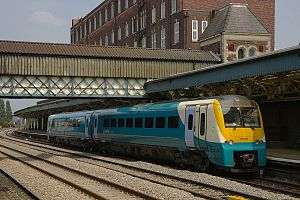 | Arriva Trains Wales | 1999-2001 | 27 | 2 or 3 | No | Diesel | The end two cars are labeled A and C irrespective of there being a coach B in the middle. |
| 180 | .jpg) | Grand Central Hull Trains | 2000-2001 | 14 | 5 | No | Diesel | |
| 334 | Abellio ScotRail | 1999-2002 | 40 | 3 | No | Pantograph | ||
| 458 | 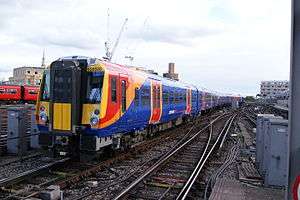 | South West Trains | 1998-2002 | 30 | 5 | Yes | Contact shoe | |
| 460 | Gatwick Express | 1999-2001 | 8 | 8 | No | Contact shoe | Withdrawn from service in 2012 to be converted to Class 458/5 for South West Trains. |
Mainland Europe
France
During October 2009, Alstom received a €800 million ($1.2 billion) order for 100 Coradia Polyvalents from French national railway operator SNCF; a €130 million option for 19 more trains was exercised in January 2010. During March 2010, the company was awarded a follow-on €135 million contract for an additional 23 Coradia Polyvalents from SNCF.[1] In May 2014, the Régiolis train was introduced by the ARF (Association of French Regions), SNCF and Alstom at the Vaugirard station in Paris. As many as 182 Régiolis trains have been ordered by 12 French Regions.[1]
Germany
The Coradia Continental is in operation with several operators in Germany. It was introduced in 2002, and has been ordered by Hamburger Hochbahn,[2] DB Regio,[3] and Hessen State Railways.[4]
The Coradia LINT is also operated, known by the local designations of DB class 640 and DB class 648. During May 2013, private operator AKN Eisenbahn ordered 14 Coradia Lints worth approximately €60 million.[1] In May 2014, Alstom delivered the first of 24 modernised Lints to Germany’s Lower Saxony State public transit authority Landesnahverkehrsgesellschaft Niedersachsen (LNVG). In April 2014, the company agreed to supply six new Coradia Lints to LNVG; that same month, a €150 million contract for of 29 Coradia Continental electrical trains was signed by Verkehrsverbund Mittelsachsen (VMS) in Central Saxony, Germany.[1]
During December 2015, Hessische Landesbahn placed a €160m contract for 30 Coradia Continental EMUs, these are intended to be ran on the Südhessen-Untermain network.[1] In March 2016, Transdev placed an order for 28 Coradia Lints for operation in Augsburg, Germany. DB Regio placed a €40 million order for eight Lints in April 2016.[1]
Sweden
The Coradia Nordic is used for Storstockholms Lokaltrafik (designated X60) for commuter services in and around the Stockholm area. During June 2012, Storstockholms Lokaltrafik had placed a €440 million ($548 million) contract for 46 Coradia Nordic trains; this reportedly brought the total orders of Nordic trains to 129.[1] Several more contracts have been realised for other Swedish operators, principally Skånetrafiken in Skåne County. During February 2015, Skånetrafiken placed an order worth approximately €150 million for 25 Coradia Nordics.[1] Both the Continental and Nordic varieties were originally marketed as Coradia Lirex.
A version of the Coradia Duplex, the SJ X40 is used by SJ AB, was originally supposed to be used for regional traffic around the lake of Mälaren in Sweden. However, SJ AB has deployed the train on an intercity route between Stockholm and Gothenburg instead.
Finland
The VR Class Sm4[5] is used for regional traffic from Helsinki to Tampere and Kouvola.
Italy
In September 2012, Alstom received a €67 million order from Ferrovie Nord Milano (FNM) for ten additional Coradia Meridian regional trains.[1] Alstom had delivered 14 trains to FNM under the agreement by 2013. FS Italian Group management ordered a further 70 Coradia Meridians from Alstom in November 2012.[1] The Coradia has been used by Trenord for the Malpensa Express service in the airport system Convoglio Servizio Aeroportuale.
North America
The Coradia LINT, was introduced in service in North America in 2015 by OCTranspo's Capital Railway in Ottawa, Ontario, Canada, where six units operate an LRT-like service as the O-train Trillium line.
Algeria
In 2018, Coradia trains were introduced in Algeria. The SNTF acquired 18 trains for their long trips between between Algiers-Oran[6] starting from Mars 2018 and Algiers-Batna[7] starting from Mai 2018. The company is also planning to use Coradia trains between Algiers-Setif. SNTF named the project "Coradia ELDJAZÏR[8]". The train Algiers-Oran has a length of 110 Meters and composed of 6 wagons with a total capacity of 254 passengers, 60 from them are first class. It can reach a speed of 160Km/h.
Accidents and incidents
- On 12 July 2016, an Alstom Coradia was involved in a head-on collision at Andria, Apulia, Italy. At least 20 people were killed.[9]
Gallery
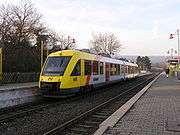
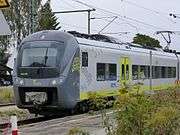
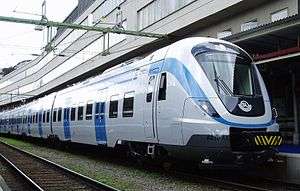




References
- 1 2 3 4 5 6 7 8 9 10 11 12 13 14 15 16 17 18 19 20 21 22 23 24 25 26 27 "Alstom Coradia Regional Trains." railway-technology.com, Retrieved: 20 May 2018.
- ↑ "BeNEX places €100m Coradia order". Railway Gazette International. 30 July 2008. Retrieved 19 March 2018.
- ↑ "DB Regio orders Saarland EMUs". Railway Gazette International. 3 May 2017. Retrieved 19 March 2018.
- ↑ "HLB orders more Coradia Continental EMUs". International Railway Journal. 15 March 2018. Retrieved 19 March 2018.
- ↑ "Archived copy". Archived from the original on 27 September 2011. Retrieved 19 August 2011.
- ↑ Thouraya, Chellouf. "Transport ferroviaire: la SNTF prévoit de nouvelles dessertes de grandes lignes sur son réseau". www.aps.dz (in French). Retrieved 2018-09-26.
- ↑ SNTF. "Coradia EL DJAZAÏR sur l'axe Alger-Batna" (in French). Retrieved 2018-09-26.
- ↑ SNTF. "Coradia EL DJAZAÏR sur l'axe Alger-Batna" (in French). Retrieved 2018-09-26.
- ↑ "Italy train crash: 'Twenty killed' near Bari". BBC News Online. 12 July 2016. Retrieved 12 July 2016.
Sources
- A. Knitter (2000), "Alstom : Doppelstockzugkonzept CORADIA Duplex", Eisenbahningenieur (in German), 51 (9): 18–20, ISSN 0013-2810
- Coradia UK
- "Дизель-поезда семейства Coradia для междугородных сообщений", Железные дороги мира (5), 2001, archived from the original on 2007-05-03
- J. Abbott (1999), Modern Railways (612): 666–670
External links
- "Coradia regional trains". www.transport.alstom.com. Archived from the original on 2012-12-16.
- "Coradia Polyvalent". www.transport.alstom.com. Archived from the original on 18 October 2010.
- "Coradia Regional Trains" (PDF). www.transport.alstom.com.